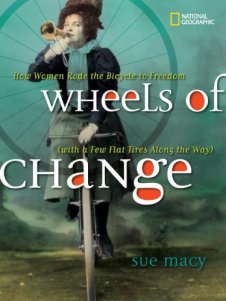(With a Few Flat Tires Along the Way)
National Geographic, 2011
96 pages, Young Adult
4 1/2 out of 5 stars
The celebration of International Women’s Day 2011, a global day to recognize the economic, political and social achievements of women past, present and future, is perhaps a perfect time to look at how the bicycle changed women’s lives in the late 19th Century and helped them ride to freedom. Sue Macy and National Geographic bring us Wheels of Change, an excellent full-color book on the history of the bicycle’s impact on society and the lives of women. To men, the bicycle was a toy but to women it was “a steed upon which they rode to a new world.”
Filled with black and white photographs, full color paintings and advertisements from the day and a wonderful eye-catching design, Wheels of Change reads more like a magazine than a history book. Your eyes flash across the page, from an anecdotal narrative to the vivid pictures inserted seemingly on every page, to the poems, songs and newspaper articles from the day, all celebrating (and often times challenging) how the women of the time embraced the bicycle. 
But history it is. Rich in detail, both educational and humorous, with a tone that is always upbeat and positive. These glossy pages are a reminder of where we’ve been, a reflection on the present. This is the type of book that leaves you enlightened by the past, optimistic about the world, and empowered for the future. Should we expect anything less from National Geographic?
The bicycle was not always just for transportation, exercise or leisure. To this day, in some parts of the world, the bicycle brings children to school, transports goods to the market, takes the sick to clinics, and imports medicine to places that need it. It saves lives. And in the late 1800’s and early 1900’s, the bicycle saved women from the constraints they had always faced.
The book is filled with amusing stories about the female celebrity cyclists of the day, lessons on cycling slang, bicycling songs and poems, and advertisements portraying how women embraced the bicycle. From the early velocipede to the rubber-tired steel-framed high-wheeler, to the modern version with two wheels of equal size and tires filled with compressed air, we learn the evolution of the bicycle along with the evolution of fashion, industry and advertising. As women switched from skirts to bloomers, and riding become more popular, the consumer culture reacted and soon repair shops were opened, manufacturers began making bicycle bells and lights, bike paths were constructed and bicycles were modified to suit a female rider. Did you know women once rode side-saddled with both legs on the same side of the bicycle? This reviewer didn’t.
 We learn about Annie Oakley, who could ride her bike no-handed while shooting at targets, and Belva Lockwood the first women to appear on an official ballot for U.S. President who rode a tricycle to work. Then there’s a great story about Annie Cohen Kopchovsky, who attempted to ride her bicycle around the world in order to settle a bet….and get this: she didn’t know how to ride a bicycle! And there was another catch – she was challenged to start with $0 and return with $5,000, a fortune for that day and age. Did she make it? How much money did she raise? It’s worth picking up Wheels of Change to find out!
We learn about Annie Oakley, who could ride her bike no-handed while shooting at targets, and Belva Lockwood the first women to appear on an official ballot for U.S. President who rode a tricycle to work. Then there’s a great story about Annie Cohen Kopchovsky, who attempted to ride her bicycle around the world in order to settle a bet….and get this: she didn’t know how to ride a bicycle! And there was another catch – she was challenged to start with $0 and return with $5,000, a fortune for that day and age. Did she make it? How much money did she raise? It’s worth picking up Wheels of Change to find out!
Like nearly every social craze, cycling by females met the usual opposition. Denounced as the downfall of women’s health and morality, the medical community quickly recognized the benefits to health but warned women: no racing! And did the women of the day pay attention? Of course not. We are rewarded with a wonderful section on female bicycle racing and how they used to race on an indoor track in front of thousands of spectators (mostly women). In an effort to settle the growing popularity of the bicycle, The Omaha Daily Bee presented women with a list of bicycling Don’ts. Don’t carry a flask. Don’t stop at road houses. Don’t wear clothes that don’t fit (this one still applies!) and most importantly: Don’t powder your face on the road.
The worries over women’s health and detriment to religious devotion were unfounded and the bicycle gave women increased independence, better health, freedom from restrictive clothing and even helped them gain the right to vote. But don’t take it from me. Sue Macy’s Wheels of Change is diligently researched, flawlessly designed and expertly executed. A wonderful book on all counts.
Wheels of Change is now available on Amazon.com.
Mark McGinty is the award winning author of The Cigar Maker and Elvis and the Blue Moon Conspiracy. His work has appeared in Cigar City Magazine and La Gaceta.


[…] Wheels of Change: How Women Rode the Bicycle to Freedom « The Boogle […]
[…] The Boogle […]
Have you ever thought about publishing an e-book or guest authoring
on other blogs? I have a blog centered on the same information you discuss and would love to have you share some stories/information. I know my viewers would value your work.
If you’re even remotely interested, feel free to shoot me an e mail.